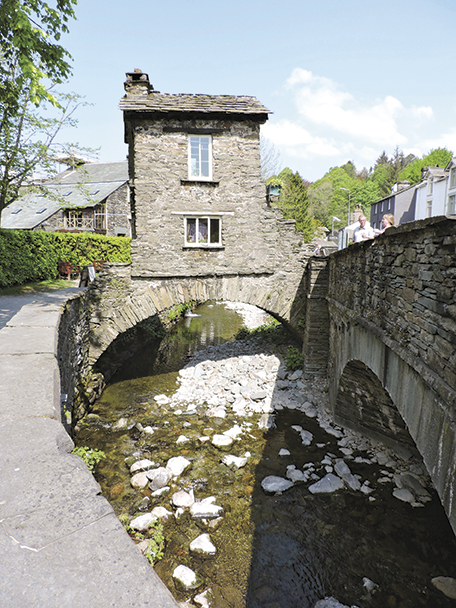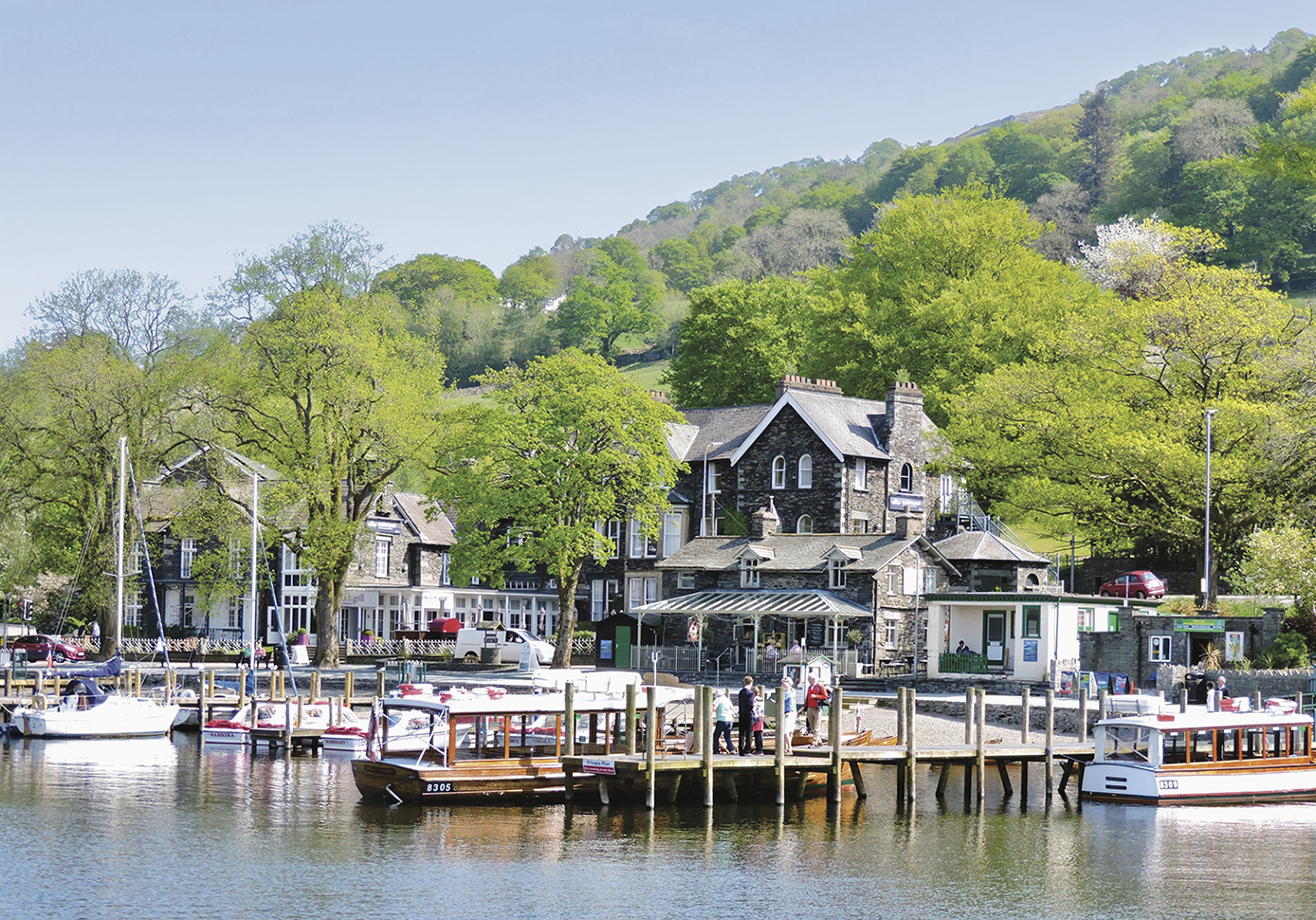Hill Top and Beyond
From The World of Beatrix Potter we strolled a few hundred yards (about 300 metres) to the Lake Windermere wharf. Here we boarded a steamer, the MV Teal, for a 1½-hour trip to Ambleside and back, basking in the sunshine on a calm lake and watching schools of kayakers overcome their wobbliness. Our other views were of the green landscape that gently sweeps up from the shore to long, low hills all around us. Clutching the shore are clusters of eccentric gingerbread Victorian buildings now mostly run as small inns and B & Bs. And of course, there were swans.
When not agitated, swans are nature’s mobile pillows; on Lake Windermere, they’re so used to people that they swim close to boats, stroll the shore, and nap on the warm pavement, forcing visitors to step around them. I enjoyed watching them sleep; a sleeping swan is serene. They looked so soft, so calm, so at peace that I half wanted to pet them, but held back. Others fed them.
Another part of our Potter experience was a visit to the Hill Top farm. To reach Hill Top, we drove our mercifully tiny car on to a small ferry for the 10-minute lake crossing from Bowness-on-Windermere to Far Sawrey and then on the B5285 road up to Hill Top. The B5285 is very narrow; in one spot, a house was so close to the road that I could have rolled my window down and rung the doorbell.
Hill Top is what you’d expect from a farmhouse; it’s tweedy and sensible. You pass a higgledy-piggledy kitchen garden to enter a large kitchen with a massive hearth and low beamed ceiling. Up a short flight of steps is a formal living room with built-in bookcases lined with leather-bound volumes of Shakespeare, Wordsworth, Dickens, and other literary giants flanking the fireplace. Though Hill Top was and remains a working farm, it was here that Potter wrote 13 of her 23 books. As instructed in her will, it’s remained untouched since she left it to the National Trust in 1943. It’s often described as her spiritual refuge. She didn’t live here—she escaped here. After her wedding to William Heelis, the couple lived in nearby Castle Cottage, leaving Hill Top as a type of large studio.
From Hill Top, we drove along the small lake called Esthwaite Water to nearby Hawkshead, the little community where Potter’s husband had his law practice. His offices are now part of the complex of buildings used as a gallery for her work. Potter had a voracious work ethic. She was constantly sketching or painting. As a result, she left more than 1,000 sketches, drawings, and watercolours. Her passion for the land and her powers of observation were important to her development as a renowned conservationist and scientist.
There was much more in the area to see, do, and visit, but our allotted time was a short three days, which I vowed not to spend in a mad rush bouncing from place to place.
We did, however, venture to Ambleside for a pint and lunch and a look around the shops. It may seem an odd comparison, but judging by the shop windows, Ambleside is a bit like Whistler, BC, in that it caters to outdoor enthusiasts, who come here to cycle, hike, and kayak. By contrast, Windermere and Bowness shops focus more on Peter Rabbit-inspired items, as well as local arts and crafts.

Bridge House, Ambleside.
Straddling a brook on the edge of Ambleside is Bridge House. Another National Trust property, it looks like the model for the old woman who lived in a shoe. The heel is on one side of the brook, the arch rises over it, and the toe grips the other side. Originally built as an apple storehouse in the 1700s, its two rooms became home to a family with six children.
In homage to Wordsworth, we stopped at Grasmere, the village he loved and lived in for 14 years. It’s so small that it’s more like a micro-village. There’s a gift shop, a hairdresser, a small grocery shop, and a charming pub with a patio in the crook of a brook across from St. Oswald’s Churchyard, where Wordsworth is buried. The church made us chuckle: as we strolled towards it, the bells played Cat Stevens’s “Morning Has Broken.” I wondered if they took musical requests.
My school friend Carol, an avid gardener, had told me that a highlight of her Lake District visit was seeing a field of Wordsworth’s daffodils (which brought to mind his so-named poem: “I wandered lonely as a cloud / That floats on high o’er vales and hills, / When all at once I saw a crowd, / A host, of golden daffodils; / Beside the lake, beneath the trees, / Fluttering and dancing in the breeze.”)
And the Food…
Our time in the Lakes was like a spa visit. The air was crisp and clean. Aside from a few harrowing minutes when I was behind the wheel (Andrew isn’t the best passenger), it was calm and relaxed. We were active. And we ate well. There were so many places that I wanted to try, but six meals a day would border on gluttony. Three meals stood out: Lindeth Howe House, the Grill & Smokehouse restaurant at The Wild Boar hotel in the hills behind Lindeth Howe, and Lake Road Kitchen in Ambleside.
Lindeth Howe was affordable luxury. Our meal was so delicious that Andrew, a very good cook, had to thank the chef. The Grill & Smokehouse restaurant was deliciously traditional. And at Lake Road Kitchen, Andrew was so overwhelmed by the food that I felt I should leave him and his plate alone together.
It’s only proper that you eat well in the Lakes, since food is a running theme in The Tale of Peter Rabbit: Peter got into trouble for nibbling Mr. McGregor’s vegetables. Mrs. Rabbit bought brown bread and five currant buns. She treated Peter’s tummy ache with chamomile tea and gave Flopsy, Mopsy, and Cotton-tail bread, milk, and blackberries.
The Lakes rate a return trip—if only to eat at all the places we missed.
Photos: Allan Lynch.




